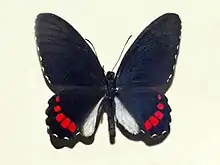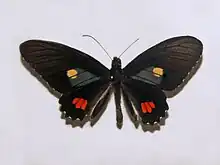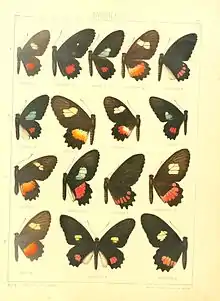| Variable cattleheart | |
|---|---|
 | |
| P. e. polyzelus | |
 | |
| P. e. erlaces male, from Peru | |
| Scientific classification | |
| Domain: | Eukaryota |
| Kingdom: | Animalia |
| Phylum: | Arthropoda |
| Class: | Insecta |
| Order: | Lepidoptera |
| Family: | Papilionidae |
| Genus: | Parides |
| Species: | P. erithalion |
| Binomial name | |
| Parides erithalion (Boisduval, 1836) | |
| Synonyms | |
| |
_female.jpg.webp)
Parides erithalion, the variable cattleheart, is a North and South American butterfly in the family Papilionidae. The species was first described by Jean Baptiste Boisduval in 1836.[1]
Description
The upperside of the wings is black with a row of red postmedian spots. The underside of the wings is also black with a row of pink and whitish spots.[1]
In males of some subspecies the uppersides of the forewings have a large olivaceous-green patch from the inner margin forward, with a creamy-white spot, while hindwings have a band of three red spots. Fringe in both sexes is dotted with white.[2]
Subspecies
- P. e. erithalion (C. Colombia) [3]
- P. e. trichopus (Rothschild & Jordan, 1906) (Mexico)
- P. e. zeuxis (Lucas, 1852) (northern Venezuela)
- P. e. erlaces (Gray, 1853) (southern Peru, northern Bolivia, Paraguay, northern Argentina)[4]
- P. e. polyzelus (C. Felder & R. Felder, 1865) (Mexico, Guatemala, El Salvador, Honduras) [5]
- P. e. lacydes (Hewitson, 1869) (eastern Ecuador)
- P. e. sadyattes (H. Druce, 1874) (Costa Rica)
- P. e. cauca (Oberthür, 1879) (western Colombia)
- P. e. xanthias (Rothschild & Jordan, 1906) (Peru)
- P. e. chinchipensis (Joicey & Talbot, 1918) (northern Peru)
- P. e. kruegeri (Niepelt, 1927) (southern Colombia)
- P. e. guillerminae Pischedda & Racheli, 1986 (northeastern Ecuador)
- P. e. yaminahua Pischedda & Racheli, 1987 (southern Peru)
- P. e. keithi Racheli, 1991 (southwestern Venezuela)
- P. e. palmasensis Brown, 1994 (western Ecuador)
- P. e. smalli Brown, 1994 (Honduras, Costa Rica, Panama)
- P. e. callegarii Racheli & Racheli, 1996 (Peru)
- P. e. inini Brévignon, 1998 (French Guiana)
- P. e. racheliorum Lamas, 1998 (Peru)
- P. e. blanca Racheli & Möhn, 2001 (Peru)
- P. e. browni Le Crom, Constantino & Salazar, 2002 (northeastern Colombia)
- P. e. chocoensis Constantino, Le Crom & Salazar, 2002 (western Colombia) [2]
Description from Seitz
P. erithalion. Male: tibiae not thickened. Hindwing without distinct red spot behind the 2. median on the upper surface. Female: the spot before the 1. median of the forewing smaller than the preceding spot; band on the hindwing broad, pale on the innerside. Costa Rica to North Venezuela. — zeuxis Luc. (= rhameses Doubl., rhesus Koll., rhamases Fldr., abilius Fldr., rhamses Boisd.) (4a). Male: the green area much narrowed anteriorly, enclosing a large white spot before the 2. median; hindwing with 2 or 3 small red spots. Female: the posterior spot of the forewing larger than the preceding one. North Venezuela and eastern side of the Cordillera of Bogota. — erithalion Boisd. (4a) from Central Colombia (Rio Magdalena) has in the male rarely a white spot on the forewing, which is placed before the 1. median or between the radials. Female: the spot before the 1. median smaller than the preceding one; generally a few small spots outside the cell. — cauca Oberth. Male: the green area of the forewing wanting or merely indicated. Female: band on the hindwing narrow, curved, separated from the cell. Cauca valle — sadyattes Druce (4a). Male: the green area very variable, generally reduced, often wanting; all specimens with at least one white spot, which is placed before or behind the 3. radial, often a green spot in the cell. Female: band of the hindwing almost unicolorous bright red. Costa Rica to Panama.[6]
 Seitz
Seitz
Description from Rothschild and Jordan (1906)
A full description is provided by Walter Rothschild and Karl Jordan (1906).[7] Note: Here polyzelus is treated as a full species and trichopus is P. z. trichopus.
Life cycle
The eggs are a brownish color. The caterpillar is brownish black with white and reddish-brown tubercles.
Host plants
The variable cattleheart feeds on Aristolochia cordiflora.
Status
It is common local species and not threatened.[8]
Taxonomy
Parides erithalion is a member of the anchises species group[9]
The members are
References
- 1 2 Glassberg, Jeffrey (2007). A Swift Guide to the Butterflies of Mexico and Central America. Sunstreak Books Inc. ISBN 978-1-4243-0915-3
- 1 2 Savela, Markku (April 7, 2019). "Parides erithalion (Boisduval, 1836)". Lepidoptera and Some Other Life Forms. Retrieved February 6, 2020.
- ↑ Lewis, H. L., 1974 Butterflies of the World ISBN 0-245-52097-X Page 26, figure 8
- ↑ Lewis, H. L., 1974 Butterflies of the World ISBN 0-245-52097-X Page 26, figure 9
- ↑ Lewis, H. L., 1974 Butterflies of the World ISBN 0-245-52097-X Page 26, figure 22
- ↑
Jordan, K. , in Seitz, A. ( 1907) . The Macrolepidoptera of the World. 5: The Macrolepidoptera of the American faunistic region. Papilionidae 1-45.
 This article incorporates text from this source, which is in the public domain.
This article incorporates text from this source, which is in the public domain. - ↑ Rothschild, W. & Jordan, K. (1906). "A revision of the American Papilios". Novitates Zoologicae. 13: 411-752. (Facsimile edition ed. P. H. Arnaud, 1967)
- ↑ Collins, N. Mark; Morris, Michael G. (1985). Threatened Swallowtail Butterflies of the World: The IUCN Red Data Book. Gland & Cambridge: IUCN. ISBN 978-2-88032-603-6 – via Biodiversity Heritage Library.
- ↑ Edwin Möhn, 2007 Butterflies of the World, Part 26: Papilionidae XIII. Parides Verlag Goecke & Evers Verlag Goecke & Evers ISBN 9783937783277
External links
- "Parides erithalion polyzelus (C. Felder & R. Felder, 1865) (Variable Cattleheart) Immatures". Butterflies of America. Retrieved February 6, 2020.
- Savela, Markku. "Larval food plant information sorted by plant - A". Lepidoptera and Some Other Life Forms. Retrieved February 6, 2020.
- "Parides erithalion (Boisduval, 1836)". Insecta.pro. Retrieved February 6, 2020.